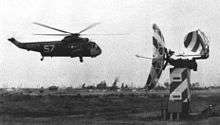Ground-controlled approach
In aviation a ground-controlled approach (GCA), is a type of service provided by air-traffic controllers whereby they guide aircraft to a safe landing, including in adverse weather conditions, based on primary radar images. Most commonly a GCA uses information from either a Precision Approach Radar (PAR, for precision approaches with vertical, glidepath guidance) or an Airport Surveillance Radar (ASR, providing a non-precision Surveillance radar approach with no glidepath guidance). The term GCA may refer to any type of ground radar guided approach such as a PAR, PAR without glideslope or ASR.[1] When both vertical and horizontal guidance from the PAR is given, the approach is termed a precision approach. If no PAR glidepath is given, even if PAR equipment is used for lateral guidance, it is considered a non-precision approach
Overview
Ground-controlled approach is the oldest air traffic technique to fully implement radar to service a plane. The system was simple, direct, and worked well, even with previously untrained pilots. It requires close communication between ground-based air traffic controllers and pilots in approaching aircraft. Only one pilot is guided at a time (max. 2 under certain circumstances). The controllers monitor dedicated precision approach radar systems, to determine the precise course and altitude of approaching aircraft. The controllers then provide verbal instructions by radio to the pilots to guide them to a landing. The instructions include both descent rate (glidepath) and heading (course) corrections necessary to follow the correct approach path.
Two tracks are displayed on the Precision Approach Radar (PAR) scope:
- Azimuth, showing the aircraft's position relative to the horizontal approach path.
- Elevation, showing vertical position relative to the published glidepath.
By following controller commands to keep the landing aircraft on both glidepath and approach centerline, a pilot will arrive precisely over the runway's touchdown zone. In order to insure continuous radio communication integrity, controllers are required to make radio transmissions at certain minimum intervals depending on the type of approach flow and phase of the approach. In order to land, pilots must have the runway or runway environment in sight prior to reaching the "decision height," for PAR approaches (usually 100–400 ft above the runway touchdown zone) or prior to the "Missed Approach Point" for non-precision approaches. The published minimum visibility and decision height/minimum descent altitude vary depending upon the approach and runway lighting, obstacles in the approach corridor, type of aircraft, and other factors. Pilots of revenue flights periodically must demonstrate PAR approach proficiency, and GCA controllers must conduct a minimum number of such approaches in a year to maintain competency.
Because of their labor-intensive nature—one GCA controller is normally required for each aircraft on final approach—GCAs are no longer in widespread use at civilian airports, and are being discontinued at many military bases. However, air traffic controllers at some locations in the United States are required to maintain currency in their use, while the Belgian Air Force still uses the PAR for ground-controlled approaches on a daily basis. NATO has kept GCA active while civil aviation adopted the instrument landing system (ILS). Global Positioning System (GPS) based approaches that provide both lateral and vertical guidance are coming into widespread use, with approach minima as good as, or nearly as good as, GCA or ILS. Modern ILS and GPS approaches eliminate the possibility of human error from the controller, and can serve many aircraft at the same time. The ground-controlled approach is useful when the approaching aircraft is not equipped with sophisticated navigation aids, and may also become a life saver when an aircraft's on-board navigation aids are inoperative, as long as one communication radio works. Sometimes the PAR-based ground-controlled approach is also requested by qualified pilots when they are dealing with an emergency on board to lighten their workload. In the United States, instrument approaches must be monitored by a PAR (if one exists with a coinciding final approach course) during certain condition such as times of darkness or low weather depending upon the controlling agency (USAF, U.S. Army, USN or FAA) or upon pilot request.[2]
Ground-controlled approaches have been depicted in several films, including Strategic Air Command, The Big Lift, Airport, Julie, and Skyjacked.
Arthur C. Clarke's novel Glide Path fictionalizes the original development of GCA.
Clarke contributed to the early application of GCA. GCA was developed during World War II to enable pilots returning to base to land safely when visibility was poor. It was essential for maintaining the flow of supplies during the Berlin airlift in 1948–49.
References
See also
- Beam Approach Beacon System
- TLS – Transponder Landing System
- AN/MPN
External links
- "Radar Becomes Lifeline." Popular Science, July 1946, pp. 82–84, first detailed article for general public on GCA radar.
